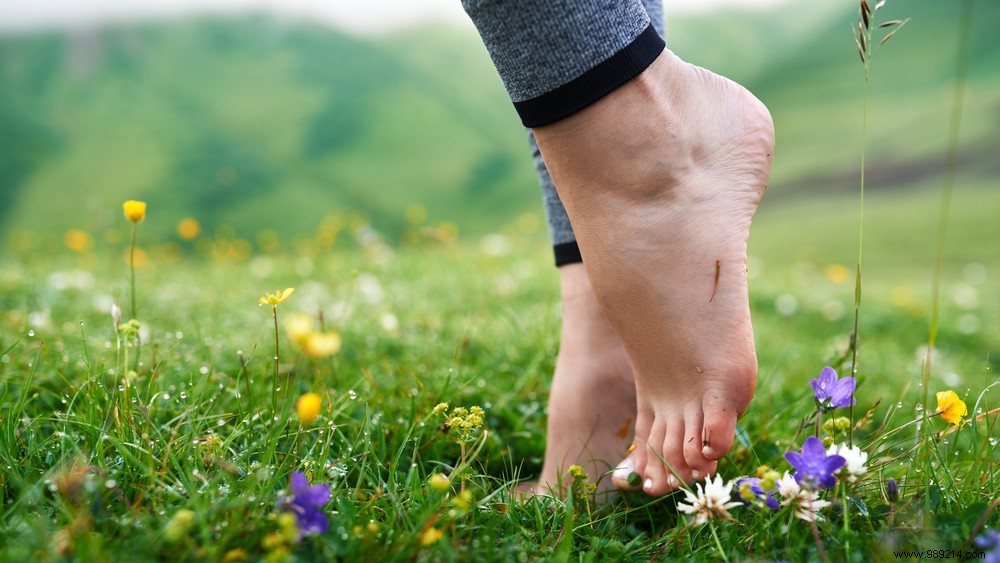
Get rid of those shoes.
Walking barefoot has long ceased to be something that only hippies do, more and more people are choosing to spend their lives – partly – without shoes. Why? Because it's surprisingly good for you.
Actresses Angelina Jolie, Shailene Woodley, Jennifer Aniston and singers Britney Spears, Katy Perry, Joss Stone and Miley Cyrus are regularly spotted in public without shoes. That looks a bit strange. In addition, your feet will get dirty and you run the risk of hurting them. It is therefore logical that we raise our eyebrows when we encounter bare feet in the wild. But is that justified?
Back in the days of our mammoth-hunting ancestors who had never heard of the word "shoe," our feet were one of the most important tools of the body. They climbed rocks, walked over twigs, thorns and other natural debris, plowed through sand and mud. Today, in the Western world, we treat our feet as soft pads that need to be pampered and pampered. Walking barefoot is something only hippies do, right? Not at all:going through life barefoot is still daily business in a large part of the world and is also gaining an increasing following in America and Europe. That is not without reason, says the American doctor Isaac Eliaz who studies vitality and resistance. 'Earthing', as it is also called, appears to bring a lot of health benefits according to various scientific studies that were published in the Journal of Environmental and Public Health.
Not surprising actually, since your feet are the basis of your entire body; the rest literally leans on it. With 26 bones, 19 muscles, 33 joints and 107 ligaments and tendons, your foot has an unprecedented range of movements, which are hindered by shoes (yes, even "good" shoes). Walking barefoot strengthens the muscles, tendons and joints in your foot, ankles and calves and helps improve your posture and balance. If you use the muscles in your feet that you don't normally use because your shoes are preventing you from doing so, your body no longer needs to correct and that helps prevent injuries to knees, hips, back and neck.
In addition, your feet play an important role in your balance, your nerve conduction and even your blood circulation. Your heart is the pump, but it can't do it alone. By tightening and relaxing your muscles, you ensure that your blood flows properly through your body and ends up in every nook and cranny. If the muscles in your foot become lazy and your blood doesn't get to the smallest places, you automatically get into a vicious circle that can eventually lead to a loss of balance and suffer from cold or sore feet.
Walking barefoot also ensures that you live more in the moment, because you have to be much more careful where you walk. In addition, the direct contact of your feet with the ground also stimulates various nerve endings and pressure points in your foot, the so-called reflex points that run from your feet to all parts of your body. Every little bump and bump in the road stimulates those points. Even if it is painful in certain places in the beginning, it is good for your body in the long run. A kind of free foot reflexology, so to speak.
Researcher Clinton Ober writes in his book Earthing that if you literally stand with your feet in the earth (or on sand, stones, wood, grass), you make contact with the magnetic field of the earth, which is full of negative ions and that affects your body. flow in as your 'nature'. These ions help you relax and therefore you sleep better and you will feel more relaxed. It may sound a bit floaty, but age-old exercises such as tai chi and yoga are probably always done barefoot. And research by American scientists in 2012 also shows that earthing balances the cortisol level in your body. We also know Coritsol as the stress hormone, which has an effect on your mood, on anxiety, depression and sleeping problems.
Perhaps the best evidence that going barefoot more often has a beneficial effect, researchers at Bournemouth University discovered. For decades they observed schoolchildren from 25 different countries who do not wear shoes in class. They appear to be a lot more relaxed than the group of children who do wear shoes in class, because there is more of a 'home feeling'. They come to school earlier on their own, read more and like to stay longer. There is also a better concentration during the lessons and there is less bullying. A good atmosphere also contributes to performance. And if it works that way for children, it might work just as positively for adults.
Practicing in the wild? Barefoot paths are popping up in more and more places in the Netherlands:routes through nature that are specially made for doing them barefoot. And those are not paved roads, but paths where you stamp your feet through the mud, walk over leaves and walk on boulders. The only thing you won't find there, for example, is garbage and ashes, so you can safely enjoy the feeling of the earth between your toes and get used to walking without shoes. These are 6 barefoot paths you can walk
Text:Rianne Sepers | Image:Shutterstock